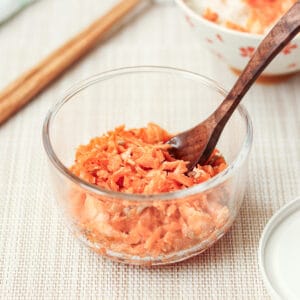Not only is salmon fillet tasty, but in Japan, people also like to eat it as Salmon Flakes. When you eat them, you’ll enjoy the rich taste of the salmon mixed with traditional Japanese flavors that are a little sweet and savory.
Salmon flakes are a healthy Japanese ingredient that can be used to make plain steamed rice taste better, to add protein to pasta or salads, or as a tasty topping for soups and noodles. It’s easy to make your own salmon flakes at home, and you can be sure that the ingredients are good. This article will teach you everything you need to know to make tasty, tender salmon flakes at home.
What are Salmon Flakes?
Salmon flakes (鮭フレーク) are made from cooked salmon that is shredded into small flakes then seasoned The fish flakes are then dried to remove moisture, which helps preserve them and intensifies the savory umami flavor. Store-bought salmon flakes can be found in the Asian section of many grocery stores, but homemade has better flavor and texture
Commonly used as:
- Topping for rice bowls
- Filling for onigiri (rice balls)
- Mix-in for pasta or salad
- Topping for soups and noodles
- Filling for omelets or hand-pies
Benefits of Salmon Flakes
Salmon is one of the best sources of heart-healthy omega-3 fatty acids like DHA and EPA. It also provides an excellent source of protein Making your own salmon flakes allows you to control the freshness and quality of the fish Other benefits include
- Long shelf life – homemade lasts 1 week refrigerated, 1 month frozen
- Convenient, ready-to-use ingredient
- Umami flavor enhancer
- Nutrient-dense topping adds protein
Tips for Making Salmon Flakes
Follow these tips for tender. flavorful DIY salmon flakes
Choose Fresh Wild Salmon
For the best texture and flavor, choose fresh wild salmon fillets without skin. Farm-raised Atlantic salmon tends to be less firm with a milder flavor. Sockeye and Coho are great wild options with deep color and rich flavor.
Cook Until Flaky
Salmon can be baked, pan-seared, or grilled until just opaque and flaky. Baking at 425F for 8-10 minutes is easiest. Don’t overcook or it will be dry.
Flake Warm Fish
Use two forks to gently flake the warm, cooked salmon into bite-size pieces while it’s still hot. This ensures tender flakes that don’t clump together.
Reduce Moisture
Cook the seasoned flakes over medium heat to evaporate moisture and concentrate the umami flavors. Stir frequently to prevent sticking and burning.
Season Generously
Salmon flakes require more seasoning than you would expect. Aim for a balance of salty, sweet, and savory. Soy sauce, sake, and mirin provide classic Japanese flavors.
Cool and Store Properly
Let cool completely before storing in an airtight container. Refrigerate up to 1 week or freeze up to 1 month.
Step-by-Step Guide
Follow this simple step-by-step guide for foolproof homemade salmon flakes every time.
Ingredients
- 1 lb fresh wild salmon fillet
- 1⁄4 tsp kosher salt
- 1 tsp toasted sesame oil
- 1 Tbsp sake
- 1 Tbsp mirin
- 2-3 tsp soy sauce
- 1 tsp toasted white sesame seeds
Directions
-
Bake the Salmon: Preheat oven to 425°F. Sprinkle salmon fillet evenly with 1⁄4 tsp salt. Bake for 8-10 minutes until opaque and flakes easily with a fork.
-
Flake the Fish: Transfer salmon to a parchment-lined baking sheet. Use two forks to gently flake fish into small, bite-size pieces. Discard any bones or skin.
-
Cook the Flakes: Heat 1 tsp sesame oil in a large non-stick skillet over medium heat. Add salmon flakes and stir to coat with oil. Cook for 2-3 minutes to evaporate moisture.
-
Season the Flakes: Add 1 Tbsp sake and 1 Tbsp mirin. Cook 1 minute until alcohol cooks off. Stir in 2-3 tsp soy sauce. Cook while stirring another 1-2 minutes until moist but not wet.
-
Finish and Cool: Remove from heat. Sprinkle with 1 tsp toasted white sesame seeds. Transfer flakes to a parchment-lined baking sheet to cool completely.
-
Store: Place cooled salmon flakes in an airtight container. Refrigerate up to 1 week or freeze up to 1 month.
And that’s it! Follow these simple steps for homemade salmon flakes anytime. Customize the flavors to your taste by using additional seasonings like ginger, garlic, or brown sugar. The versatile flakes can be enjoyed as a topping for rice, stirred into pasta, tossed into salads, or snacked on straight from the jar!
Recipe Ideas
Homemade salmon flakes are endlessly versatile. Here are some of my favorite ways to use them:
As a Rice Topping
- For a quick salmon rice bowl, spoon salmon flakes over hot steamed white or brown rice.
- Mix into fried rice or rice pilaf along with vegetables.
- Sprinkle on top of rice porridge or congee.
In Soups & Noodles
- Make salmon ramen by topping noodles with flakes and hot broth.
- Add to udon noodle soup for extra protein.
- Toss into stir-fried noodles along with veggies.
With Vegetables & Grains
- Use as a protein topping for roasted veggies like carrots or broccoli.
- Mix into cold grain-based salads like farro or quinoa.
- Stir into hot oatmeal or congee instead of furikake.
As a Filling/Topping
- Fill onigiri rice balls or use as a topping.
- Spoon into puff pastry and bake into salmon pies.
- Add to egg mixture and make salmon tamagoyaki.
For Snacking
- Eat the flakes straight from the jar for a savory, umami snack.
- Sprinkle on top of avocado toast or crackers.
Let your imagination run wild with all the possibilities! Homemade salmon flakes are sure to become a new pantry staple.
FAQ
Here are answers to some commonly asked questions about making and using DIY salmon flakes:
Can I use canned salmon?
For best flavor and texture, fresh or frozen salmon fillets are recommended. Canned salmon will work but may have a softer texture.
How long does it keep in the refrigerator or freezer?
Properly stored in an airtight container, salmon flakes will last up to 1 week in the fridge or 1 month in the freezer.
What’s the best way to thaw frozen salmon flakes?
To thaw, move frozen salmon flakes to the refrigerator overnight. For a quick thaw, place the sealed bag or container under cool running water for 10-15 minutes.
Can I flavor the flakes with other seasonings?
Absolutely! Some ideas are lemon zest, sesame oil, sriracha, brown sugar, furikake, Japanese 7-spice blend. Get creative with your favorite flavor combo.
What are good salmon substitutes if I can’t find it fresh?
Any firm white fish like halibut, cod, or sea bass can be used. You can also make tuna flakes using this same method.
Make Delicious Salmon Flakes at Home
With this easy tutorial, you can now make amazing salmon flakes at home to enjoy as a nutritious topping, mix-in, or snack anytime. Customize the flakes to your taste and get creative with how you use them in recipes. You’ll never need store-bought again after making your own incredibly fresh, flavorful salmon flakes. Enjoy this versatile Japanese staple in rice bowls, pastas, sandwiches, salads, and more for a pop of savory umami flavor.

What are Salmon Flakes?
To make salmon flakes, you cook salmon fillets, flake the meat, and season them with traditional Japanese spices like sake and mirin. Then you add them to rice. In Japan, people of all ages like to put them on top of rice or use them to fill onigiri (rice balls). They taste great when they are fresh, but most people make them as a rice condiment to have on hand.
Asian markets sell salmon flakes that are ready to eat, but homemade ones are much better because they don’t have any added ingredients. People often eat them too quickly because they taste so good, so it’s best to make a bigger batch and spread them out over a few days.
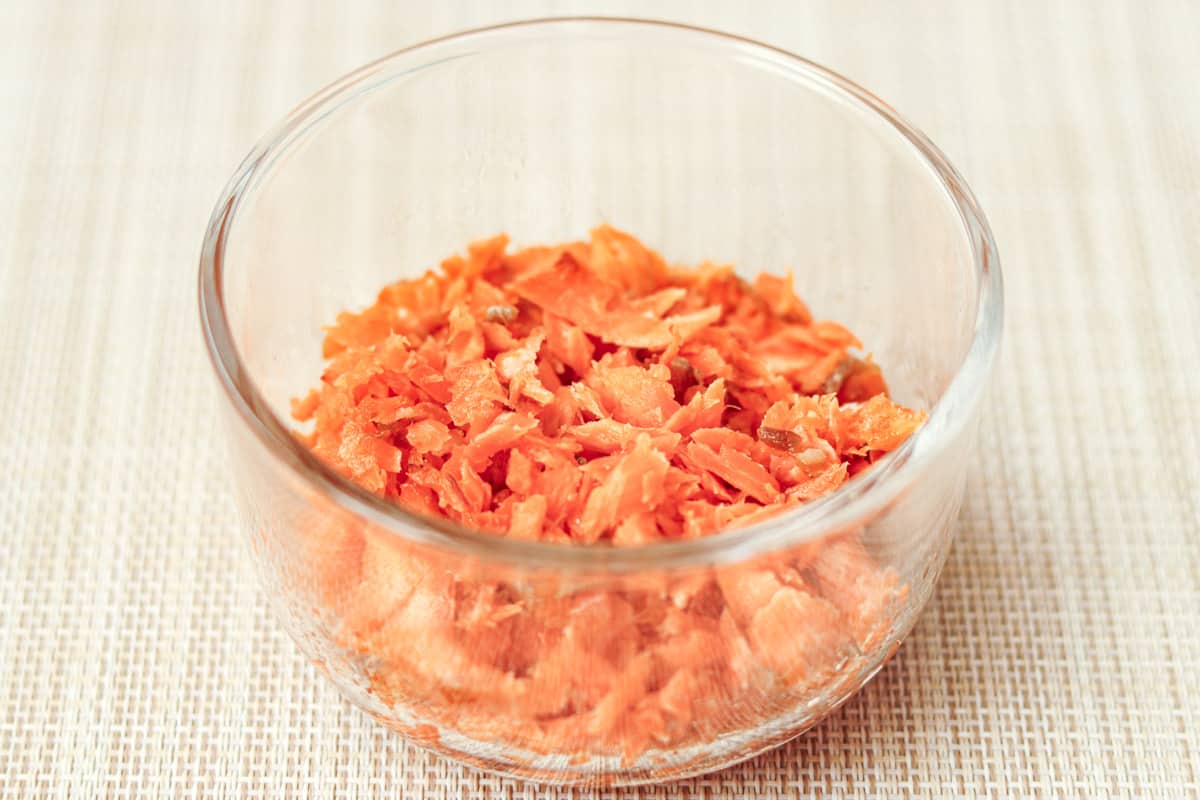
Types of salmon used
There are various types of salmon, and you can make salmon flakes with any of them. If the salmon is fatty, the flavor will be even more enhanced. The color might be a little different depending on the type of salmon you use, but that’s okay because they are all natural salmon colors.
As a finishing touch to salmon flakes, it is common to add sesame oil or toasted sesame seeds. While not absolutely necessary, incorporating them enhances the flavor profile. You can use both if you want, but this recipe only calls for sesame oil to keep the texture moist.
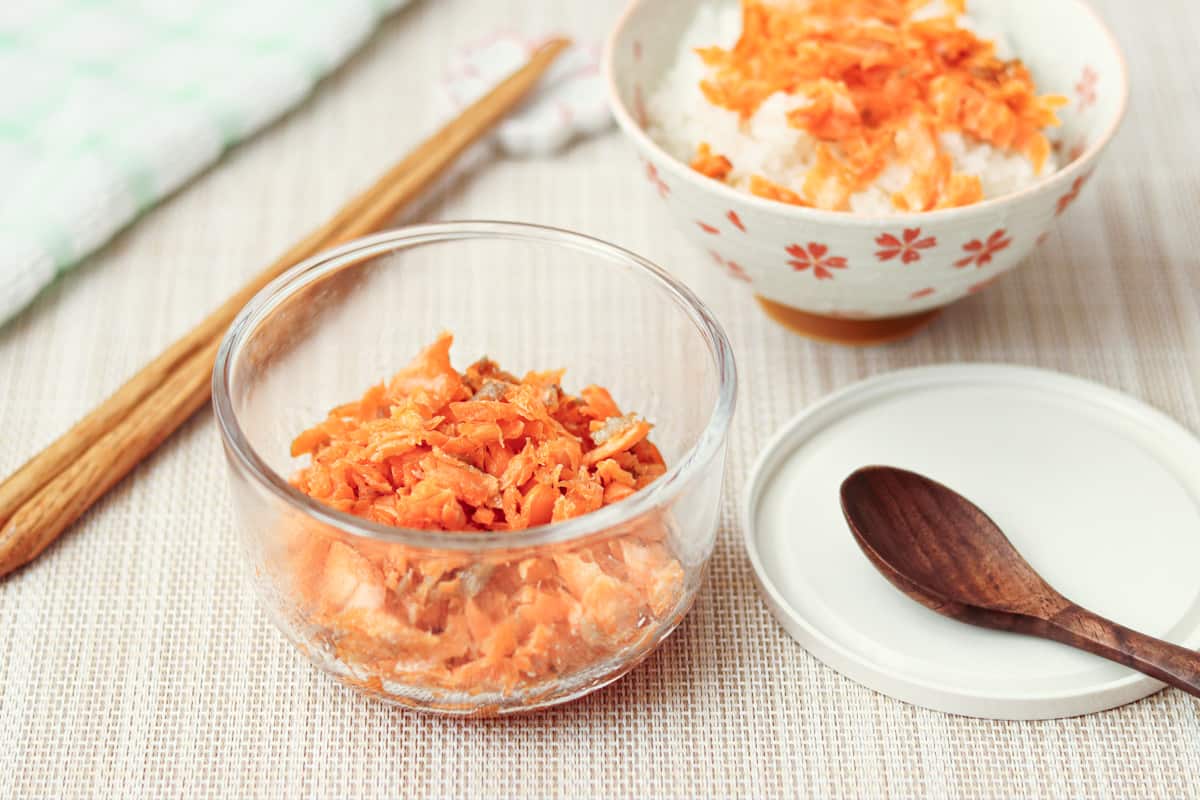
- ▢ 2 (6.4oz./180g) salmon fillets
- ▢ ½ Tbsp sesame oil
- ▢ 3 Tbsp sake
- ▢ 2 Tbsp mirin
- ▢ ½ tsp salt
Total 15 mins
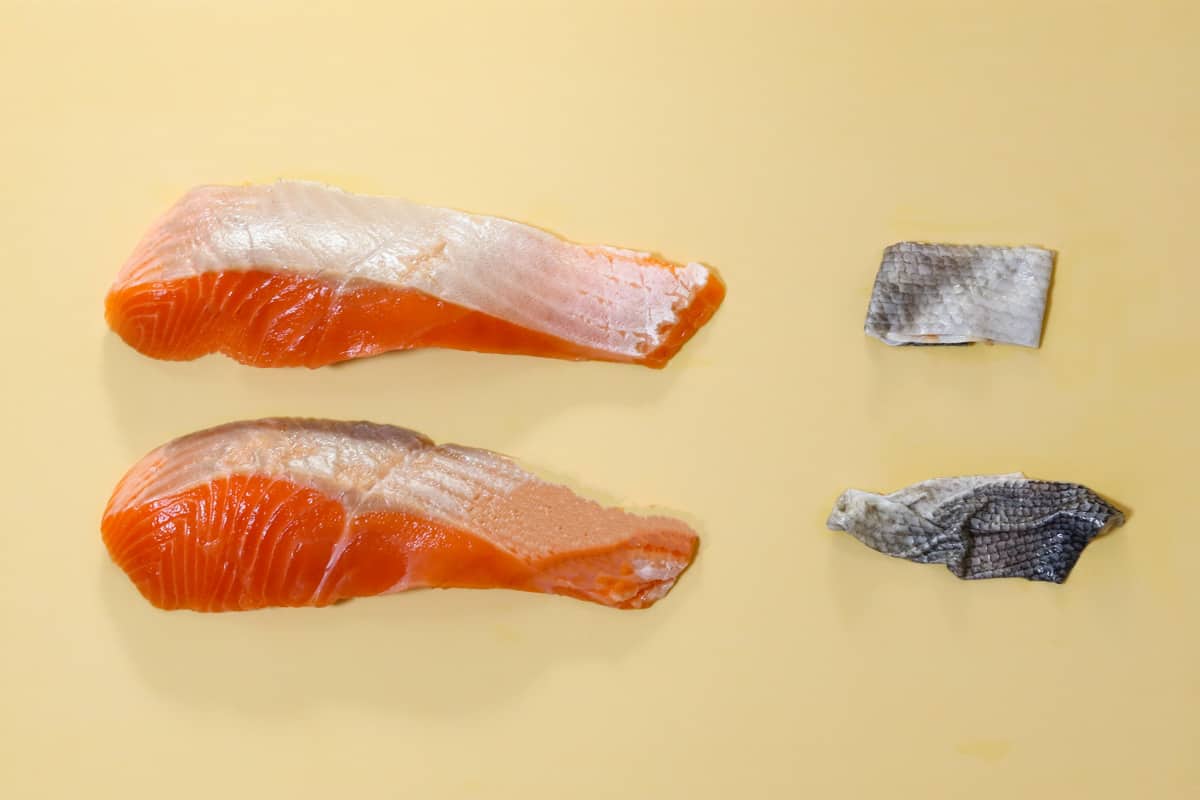
Step 1 Remove the scales, skin, and bones from the salmon fillets.
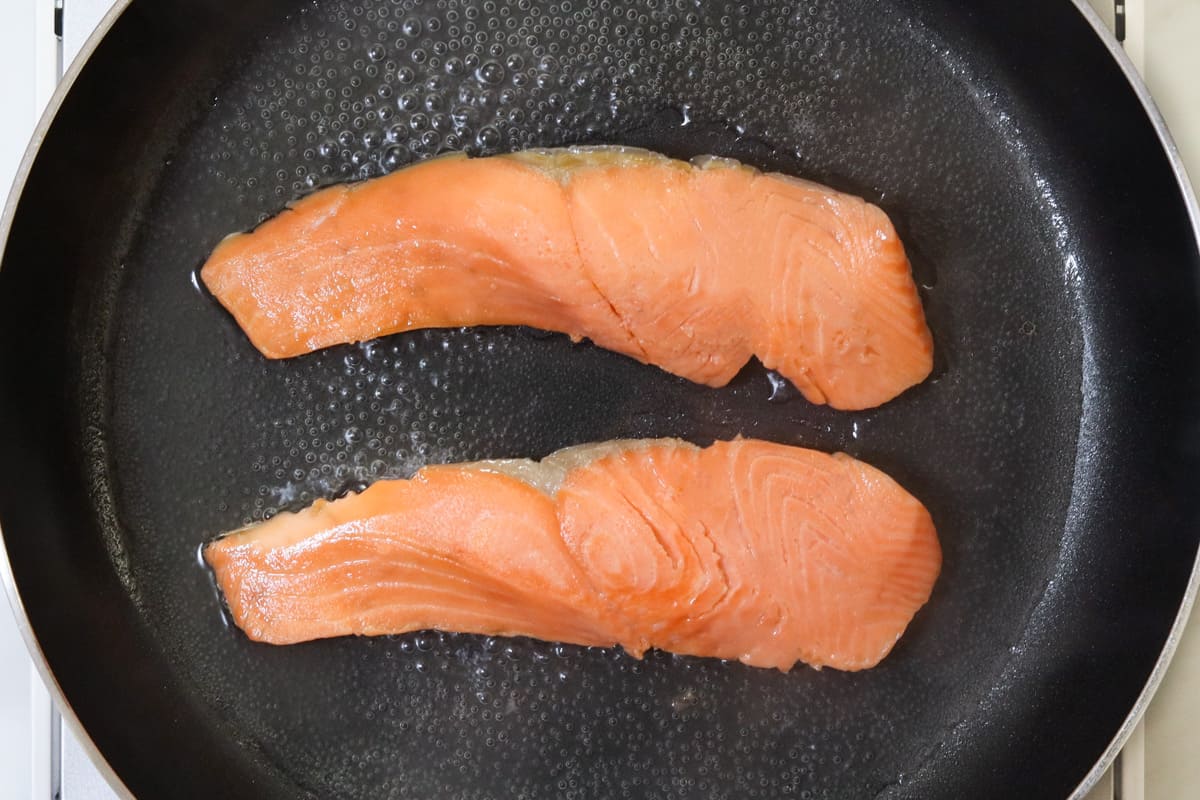
Step 2: Put the salmon fillets in a pan and add the sake, mirin, and salt. Simmer over medium heat for 4 minutes, turning the fillets over halfway through.
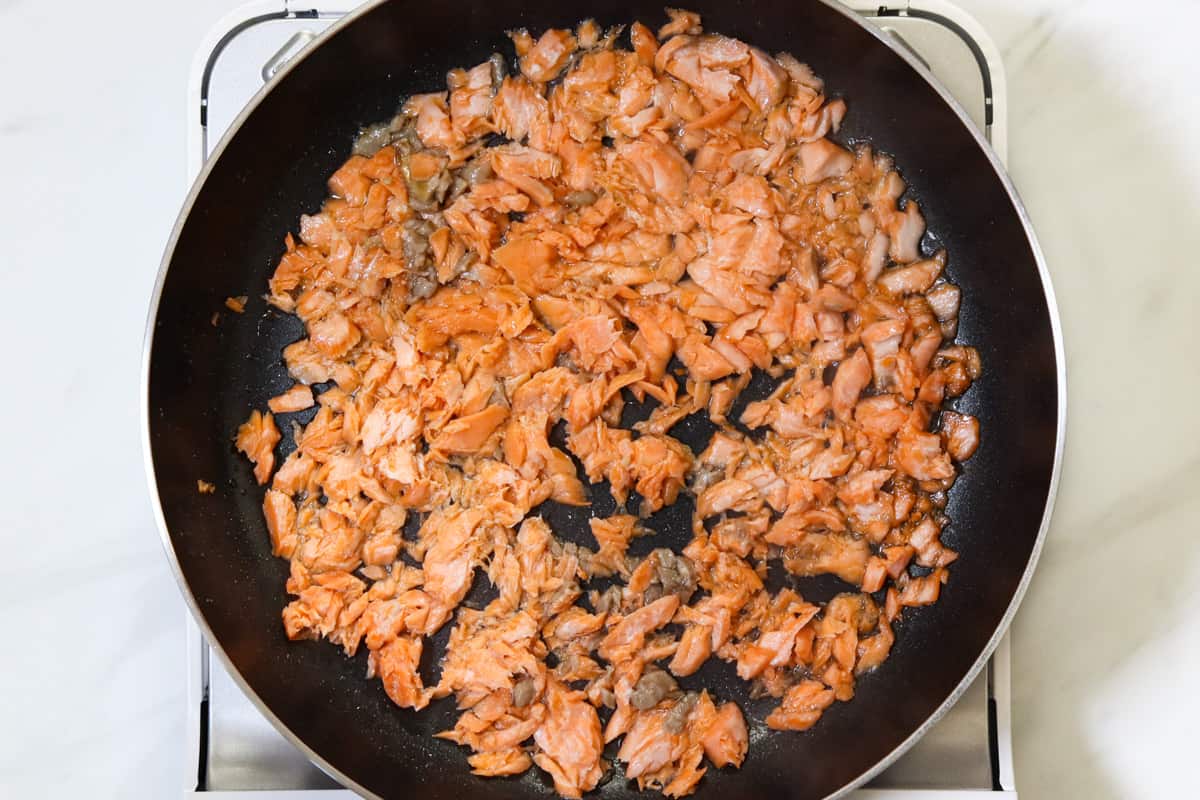
Step 3 Cook the salmon fillets, breaking them into smaller pieces with a spatula.
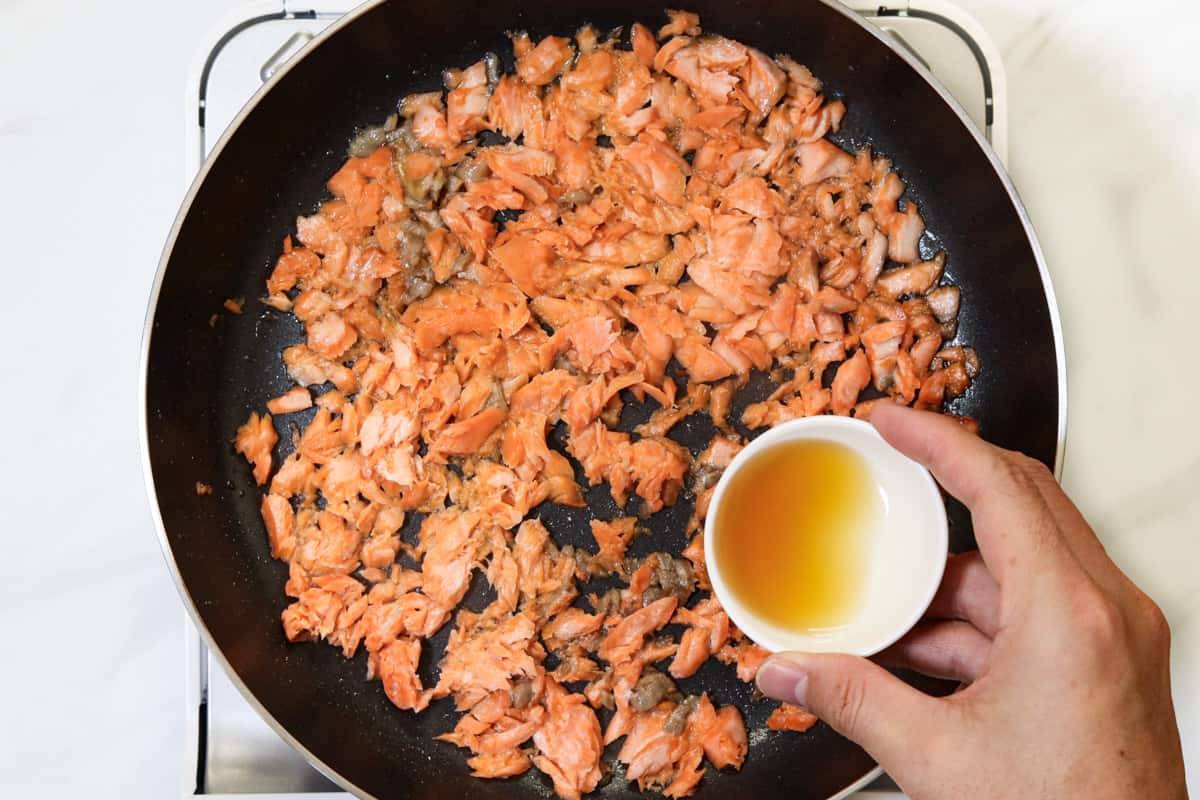
Step 4: Once most of the seasoning liquid is gone, add the sesame oil and cook for one more minute.
They will last up to 5 days in the fridge if you put them in a container that doesn’t let air in.
